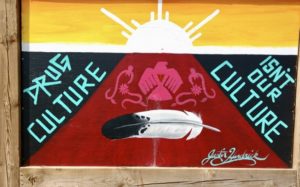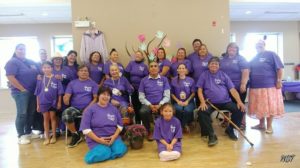Chippewas of the Thames First Nation launch harm reduction program

By Colin Graf
CHIPPEWAS OF THE THAMES FIRST NATION—Workers at the health centre in Chippewas of the Thames First Nation (COTTFN) are making a new effort to bring hope to community members. They’re launching a harm reduction program for intravenous drug users in an effort to keep users as safe as possible and offer them help to quit if they’re ready to try.
Health Director in COTTGN, Kimberly Fisher, says that a rash of overdoses and deaths in the community has prompted the new program.
“We’ve had community members come in and asking us, ‘What are these needles for? We’re finding them in our grandson or granddaughter’s room, and we don’t really know what to do’.”
According to Fisher, the community is experiencing a lot of opioid and fentanyl use, much of which is being injected.
“We knew we needed to get a needle exchange going, but also some wrap-around harm reduction for individuals who are using.”
As with many First Nations, Fisher says transportation is a barrier that prevents drug users from getting to the nearby city of London where health facilities offer free clean supplies.
With money from the provincial health ministry’s reconciliation initiative, local workers launched their mobile harm reduction service on Aug. 20, serving members of three adjacent First Nations in southwestern Ontario that include Chippewas of the Thames, Munsee Delaware Nation and Oneida of the Thames.
In cities that offer harm reduction services, users often go to a harm reduction site; the COTTFN service goes to the users, bringing clean supplies such as needles and sterile water without charge.
“When we go, we try to do some education to show them how they’re shooting up,” says Dean Doxtator, cultural outreach manager. “Some are doing it right and some are doing it incorrectly and are actually doing [more] harm to themselves.”
“They aren’t all tying off properly,” he explains, referring to the practice of tying a tight tourniquet to an arm before injecting. According to Doxtator, loosening the tourniquet slowly allows the drug to enter the blood system at a controlled rate. Doing it incorrectly can cause blood clots.
Doxtator adds that the workers also provide the individual or family with a Naloxone kit, which can reverse the effects of an overdose, and training on how to administer it.
While the workers’ focus is on harm reduction, they also offer to help the users get off drugs if they want to.

“When they’re ready, we’re here to give them support. If they decide they want to stop using we put them in contact with appropriate supports,” Doxtator explains, adding that they also include residential treatment centres.
Doxtator adds that there are 17 First Nations in Ontario with culturally sensitive drug and/or alcohol treatment centres in Ontario.
The mobile unit is meeting with some early success, according to Doxtator. Two people that his team has visited are preparing to go for treatment, one in September and one in October. Doxtator, who has experienced overdose in his family, says his training on the streets of London with the London Regional HIV/AIDS Connection was eye-opening.
“I didn’t understand the importance of the non-judgmental approach before and how important harm reduction is.”
Fisher notes that the harm reduction program includes a unique indigenous component: the use of the traditional medicines sage, cedar, and sweetgrass. She adds that this component has brought a real connection for some of the team’s clients, even causing emotional moments.
“We are connecting them back to our culture,” she says.
The workers may offer an addict a chance to speak with a traditional healer as well. In return for the help, the group has received traditional medicine supplies for urban Indigenous drug users from the London group.
Response to the new initiative from the COTTFN community is positive, says Doxtator.
“What I’ve been hearing is, ‘How come our own people aren’t doing this?’. This is what has been talked about for years, and now we’re here and we’re up and running and we have our own First Nations people actually doing this harm reduction on a cultural approach,” he says.
Fisher says that the COTTFN health centre has also created another team that has been staffing a 24-hour crisis phone line since June 1. She adds that anyone from First Nations across the region who feels they are in need can call 1-866-289-0201 and speak to a live person about their issues. The service is being promoted there, as well as in Aamjiwnaang, Kettle & Stony Point, and Munsee Delaware Nation. The three-member crisis team also travels to each community one day a week to offer support services such as training in suicide prevention and grief counselling, according to Fisher. The group expects to hire a fourth worker soon.
While the harm reduction group only works Mon.-Fri. from 10:00 am-6:00 pm, drug users who need help can still access the crisis line 24/7 and leave a message for those workers, Fisher says. The team can respond to the call first thing the next morning and know they have to take clean supplies to a user “a little earlier than anticipated,” she details. Funding is in place to keep the three harm reduction workers going for three years.
COTTFN held their first International Overdose Awareness Day event Fri. Aug. 31 to help educate the community on how to help drug users and to share stories of loved ones who have died from overdose. A sunrise ceremony and breakfast was held, and Naloxone training offered. Councillor Darlene Whitecalf spoke of the death of her daughter Pamela from an accidental overdose in 2017.


